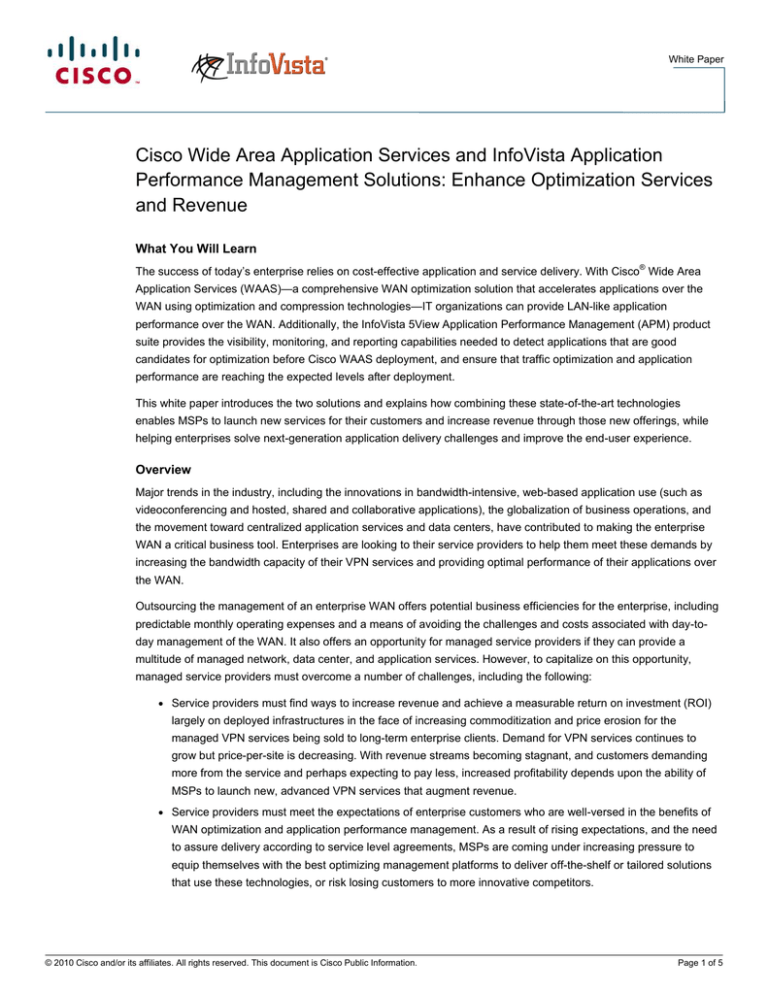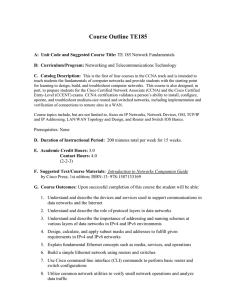
White Paper
Cisco Wide Area Application Services and InfoVista Application
Performance Management Solutions: Enhance Optimization Services
and Revenue
What You Will Learn
The success of today’s enterprise relies on cost-effective application and service delivery. With Cisco® Wide Area
Application Services (WAAS)—a comprehensive WAN optimization solution that accelerates applications over the
WAN using optimization and compression technologies—IT organizations can provide LAN-like application
performance over the WAN. Additionally, the InfoVista 5View Application Performance Management (APM) product
suite provides the visibility, monitoring, and reporting capabilities needed to detect applications that are good
candidates for optimization before Cisco WAAS deployment, and ensure that traffic optimization and application
performance are reaching the expected levels after deployment.
This white paper introduces the two solutions and explains how combining these state-of-the-art technologies
enables MSPs to launch new services for their customers and increase revenue through those new offerings, while
helping enterprises solve next-generation application delivery challenges and improve the end-user experience.
Overview
Major trends in the industry, including the innovations in bandwidth-intensive, web-based application use (such as
videoconferencing and hosted, shared and collaborative applications), the globalization of business operations, and
the movement toward centralized application services and data centers, have contributed to making the enterprise
WAN a critical business tool. Enterprises are looking to their service providers to help them meet these demands by
increasing the bandwidth capacity of their VPN services and providing optimal performance of their applications over
the WAN.
Outsourcing the management of an enterprise WAN offers potential business efficiencies for the enterprise, including
predictable monthly operating expenses and a means of avoiding the challenges and costs associated with day-today management of the WAN. It also offers an opportunity for managed service providers if they can provide a
multitude of managed network, data center, and application services. However, to capitalize on this opportunity,
managed service providers must overcome a number of challenges, including the following:
●
Service providers must find ways to increase revenue and achieve a measurable return on investment (ROI)
largely on deployed infrastructures in the face of increasing commoditization and price erosion for the
managed VPN services being sold to long-term enterprise clients. Demand for VPN services continues to
grow but price-per-site is decreasing. With revenue streams becoming stagnant, and customers demanding
more from the service and perhaps expecting to pay less, increased profitability depends upon the ability of
MSPs to launch new, advanced VPN services that augment revenue.
●
Service providers must meet the expectations of enterprise customers who are well-versed in the benefits of
WAN optimization and application performance management. As a result of rising expectations, and the need
to assure delivery according to service level agreements, MSPs are coming under increasing pressure to
equip themselves with the best optimizing management platforms to deliver off-the-shelf or tailored solutions
that use these technologies, or risk losing customers to more innovative competitors.
© 2010 Cisco and/or its affiliates. All rights reserved. This document is Cisco Public Information.
Page 1 of 5
White Paper
●
As the number of IP applications, customer sites, and users increase, meeting bandwidth demands will
require innovative, efficient use of bandwidth throughout the network. With global, national, and regional
variations in service-access types, ranging from leased line to DSL, fiber, and Ethernet, service providers and
their customers need to understand bandwidth capacity use and trends in all parts of the network to help
ensure unhindered application delivery.
●
The need to increase revenue in difficult economic conditions puts pressure on MSPs and enterprises to
control costs and optimize ROI. To accomplish this, it is critical for MSPs to invest in a unified, scalable,
multitenant platform to monitor application-aware and WAN optimization services.
To address these challenges, service providers are beginning to understand the need to move beyond the traditional
approach to delivery of enterprise services by offering customers user-experience and application-focused features
that have gained importance in today’s business services environment and have a perceived high value. Valueadded, application-aware offerings addressing these challenges and trends can be categorized to enable a smooth
and staged introduction into the business services portfolio. As shown in Figure 1, the logical approach to
implementing an application-aware offering can consist of two functional sets—visibility services and optimization
services—that can ultimately culminate in intelligent, policy-controlled, application-control services. These product
extensions and offerings address a service provider’s need to generate new revenue streams and differentiate
service offerings, while at the same time meet the enterprise customer’s need for increased visibility and assurance
of VPN service and application performance in addition to concerns over escalating bandwidth requirements and
costs.
Figure 1.
Application-Based Service Offerings
© 2010 Cisco and/or its affiliates. All rights reserved. This document is Cisco Public Information.
Page 2 of 5
White Paper
Understanding Application Deployment
In the past, to get a comprehensive understanding of application use and deployment across the corporate network,
enterprises have deployed internally managed solutions throughout their environments. Service providers now have
the opportunity to offer this visibility as an extension to existing managed VPN services. Data provided by application
use visibility helps identify bandwidth-intensive applications, aids in rapid troubleshooting and proactive resolution of
application-based network performance problems, and enables detection of rogue activity occurring on the network.
This logical first step can not only provide informed visibility but will assist enterprises in determining the best use of
the numerous classes of service (CoSs) offered within the managed VPN. Applications—per site—can be correctly
classified as to their performance characteristics and apportioned to an appropriate class: real time, best effort, etc.
Making Informed Decisions About Optimization
With an understanding of application deployment, an enterprise, with the aid of its service provider, can work toward
optimizing its use of the WAN. Cisco® Wide Area Application Services (WAAS) provides a comprehensive WAN
optimization solution that accelerates applications over the WAN, delivers video to the branch office, and provides
local hosting of branch-office IT services. These capabilities help organizations centralize applications and storage in
the data center, maintain LAN-like application performance, and provide locally hosted IT services while reducing the
overall branch-office device footprint.
Measuring Response Time for Optimized Applications
While optimization and acceleration techniques have become popular as a means of improving application efficiency
over the WAN, they also present new challenges for measuring the response time for the optimized applications.
Application performance indicators can be very different depending on where they are measured on the network.
Typically, when an application is optimized by a Cisco WAAS architecture, the behavior of the TCP transactions can
be modified. Therefore, the usual techniques that measure application response time based on TCP handshake and
synchronization may lead to inaccurate results.
Traditional solutions for application monitoring were typically designed to be deployed in the data center. However,
when applications are optimized between branch offices and the data center, measuring application performance
from the data center may inaccurately measure the user experience. Moreover, installing the same monitoring
devices in all branch offices as those used in the data center would have prohibitive costs.
To address the challenge of optimized application response time, Cisco offers embedded technology, called flow
agents, in Cisco Wide Area Application Engine (WAE) devices; these flow agents enable the forwarding of application
information, such as application response time, to a Cisco Network Analysis Module (NAM) product. The Cisco NAM
portfolio comes in many form factors—integrated service modules, virtual blades, and self-contained appliances—
providing the flexibility and scalability needed for the targeted environment. This strategy makes it possible to gain an
understanding of the user experience from all the network locations without excessive deployment costs.
Combining Technology Solutions for Effective WAN Optimization
Service providers seeking to offer WAN bandwidth and application optimization as part of their business services
portfolios should consider two primary components:
●
Networking technology and WAN optimization devices (WODs)
●
Visibility into the service and performance assurance through detailed reporting and monitoring
InfoVista 5View Application Performance Management and Cisco WAAS
The InfoVista 5View Application Performance Management (APM) product suite provides the visibility, monitoring,
and reporting capabilities needed to support the creation and delivery of the second component of a service
provider’s application-aware product portfolio. The 5View APM solution makes it possible to detect applications that
© 2010 Cisco and/or its affiliates. All rights reserved. This document is Cisco Public Information.
Page 3 of 5
White Paper
are good candidates for optimization and can empower users with the information required to make informed
decisions prior to Cisco WAAS deployment.
InfoVista’s WAN optimization assurance then provides the critical component—visibility and reporting—to monitor the
optimized network environment after Cisco WAAS has been deployed. This capability delivers the information needed
to help ensure that traffic optimization and application performance are reaching the expected levels.
InfoVista 5View Application Optimization Manager (AOM) collects, analyzes, and aggregates data from the WODs to
measure WAN optimization service performance at both the TCP and application layers. A standard set of important
out-of-the-box key performance indicators (KPIs) are provided, such as the amount of original traffic, pass-through
traffic, optimized traffic, and percentage bandwidth reduction. These indicators help in quantifying and ensuring
bandwidth savings from a Cisco WAAS deployment. In addition to the out-of-the-box reports, InfoVista 5View AOM
can generate customized reports and a view into workflow that provides the information needed to handle the most
common troubleshooting scenarios and rapidly deploy solutions (Figure 2).
Figure 2.
Typical InfoVista 5View, Cisco WAAS, and Cisco NAM Deployment
© 2010 Cisco and/or its affiliates. All rights reserved. This document is Cisco Public Information.
Page 4 of 5
White Paper
InfoVista 5View and the Cisco NAM
The integration of InfoVista 5View Service Data Manager (SDM) and Cisco NAM (SDM-NAM) helps ensure the best
approach to measuring, monitoring, and reporting on optimized application response-time metrics. This integration
enables aggregation and correlation of the data from multiple Cisco NAM devices, presenting it in a single application
performance management and reporting environment, and enables the service provider to sort the data by individual
customer, making the integration truly multi-tenant and critical to a service provider’s product strategy. This approach
enables service providers and large enterprises to deliver customer experience measurements using Cisco NAM
collected statistics.
The InfoVista solution provides a real-time, scalable, and efficient aggregation, analysis, and presentation engine for
application-related metrics. After application acceleration techniques are employed, the response data or reports can
show before-and-after status and provide ongoing monitoring capability.
Conclusion: Achieving an Optimal Application Performance Experience
In today’s enterprise network environment, application-centric network performance management is critical to
achieving an optimal application performance experience. Combining state-of-the-art technologies to respond to this
business requirement allows managed service providers to launch new services for their customers and increase
revenue through those offerings, while enabling organizations to improve the performance of their applications over
the WAN, support their increased bandwidth consumption, and address rural and remote bandwidth limitations while
reducing their IT management costs.
For More Information
http://www.infovista.com/content/business-services
http://www.cisco.com/go/waas
Printed in USA
© 2010 Cisco and/or its affiliates. All rights reserved. This document is Cisco Public Information.
C11-593355-00
03/10
Page 5 of 5




